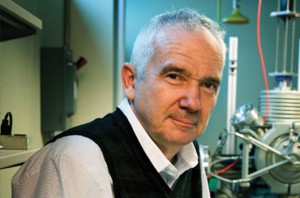The Center for the Advancement of Science In Space (CASIS), in conjunction with NASA, has recently awarded a grant to Aleksandar Ostrogorsky, professor of materials and aerospace engineering at Armour College of Engineering, to prepare and conduct eight crystal growth experiments aboard the International Space Station (ISS). Ostrogorsky’s investigation is one of three materials science projects selected for funding by CASIS. CASIS was selected by NASA in July 2011 to maximize use of the ISS U.S. National Laboratory through 2020 and is dedicated to supporting and accelerating innovations and new discoveries that will enhance the health and wellbeing of people and our planet.
Ostrogorsky is PI on the project entitled “Detached Melt and Vapor Growth of InI in SUBSA Hardware,” and a consultant on the project led by Alexei Churilov, of Radiation Monitoring Devices (RMD). The goal is to find a technique for producing high purity low-defect semiconductor and scintillator crystals that would yield better and less expensive detectors of nuclear radiation.
Both projects will be conducted in the Microgravity Science Glovebox (MSG) facility, which allows the astronauts to operate the experiment by inserting their hands into a pair of gloves that reach inside the box.
In microgravity, the crystals usually grow “detached” with little or no contact and contamination with the container wall. Furthermore, there is no gravity-driven melt flow, transporting the impurities towards the crystal. Thus, the crystallographic and chemical perfection of detached crystals is often improved by several orders of magnitude. Therefore, the crystals’ ability to detect radiation should be drastically improved.
This will be the second time Ostrogorsky has had a research project conducted on the ISS. In 2002, he was PI of the project called “Solidification Using a Baffle in Sealed Ampoules” (SUBSA), also conducted in MSG (see photo above). At that time the “SUBSA furnace” with a transparent section was designed and built to allow observation of the process – how semiconductor crystals form in space.
The current project is focused on Indium Iodide (InI), a semiconductor that holds promise as a detector of nuclear radiation. Ostrogorsky’s goals are to produce InI crystals having “benchmark” quality, and to develop a process to grow InI crystals, inexpensively, on earth.
Cadmium Zinc Telluride is expensive and “grows” slowly, ~ 5 mm/day. During the past 5 years, under the sponsorship of the Department of Defense’s National Nuclear Security Agency, Ostrogorsky and his team demonstrated that InI crystals can be produced approximately 50 times faster, at ~10 mm/hr.
InI is suitable for experiments at the ISS, because it is a non-toxic and safe to use within the confines of the ISS. It also has a melting point close to that of InSb, for which the SUBSA furnace was originally designed.
Ostrogorsky hopes to produce an InI crystal with the highest achievable perfection, in order to determine if InI can compete with the leading room temperature detector material, Cadmium Zinc Telluride (CZT). If the results from the ISS experiment are favorable, further research will be done back on earth to develop the material into a viable commercially available detector. The experiments on the ISS will be mirrored on earth for in order to compare results.
For more information, please visit the ISS U.S. National Laboratory Website here.

